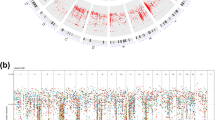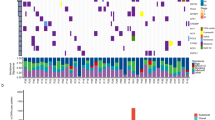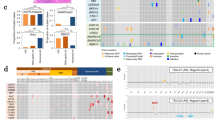Abstract
Small-cell lung cancer (SCLC) is an aggressive lung tumor subtype with poor prognosis1,2,3. We sequenced 29 SCLC exomes, 2 genomes and 15 transcriptomes and found an extremely high mutation rate of 7.4 ± 1 protein-changing mutations per million base pairs. Therefore, we conducted integrated analyses of the various data sets to identify pathogenetically relevant mutated genes. In all cases, we found evidence for inactivation of TP53 and RB1 and identified recurrent mutations in the CREBBP, EP300 and MLL genes that encode histone modifiers. Furthermore, we observed mutations in PTEN, SLIT2 and EPHA7, as well as focal amplifications of the FGFR1 tyrosine kinase gene. Finally, we detected many of the alterations found in humans in SCLC tumors from Tp53 and Rb1 double knockout mice4. Our study implicates histone modification as a major feature of SCLC, reveals potentially therapeutically tractable genomic alterations and provides a generalizable framework for the identification of biologically relevant genes in the context of high mutational background.
This is a preview of subscription content, access via your institution
Access options
Subscribe to this journal
Receive 12 print issues and online access
$209.00 per year
only $17.42 per issue
Buy this article
- Purchase on SpringerLink
- Instant access to full article PDF
Prices may be subject to local taxes which are calculated during checkout





Similar content being viewed by others
References
Gustafsson, B.I., Kidd, M., Chan, A., Malfertheiner, M.V. & Modlin, I.M. Bronchopulmonary neuroendocrine tumors. Cancer 113, 5–21 (2008).
Travis, W.D. Lung tumours with neuroendocrine differentiation. Eur. J. Cancer 45 (suppl. 1), 251–266 (2009).
van Meerbeeck, J.P., Fennell, D.A. & De Ruysscher, D.K. Small-cell lung cancer. Lancet 378, 1741–1755 (2011).
Park, K.S. et al. A crucial requirement for Hedgehog signaling in small cell lung cancer. Nat. Med. 17, 1504–1508 (2011).
World Health Organization. Pathology and Genetics of Tumours of the Lung, Pleura, Thymus and Heart (eds. Travis, W.D., Brambilla, E., Müller-Hermilink, H.K. & Harris, C.C.) 344 (IARC Press, Lyon, France, 2004).
Tiseo, M. & Ardizzoni, A. Current status of second-line treatment and novel therapies for small cell lung cancer. J. Thorac. Oncol. 2, 764–772 (2007).
Kwak, E.L. et al. Anaplastic lymphoma kinase inhibition in non-small-cell lung cancer. N. Engl. J. Med. 363, 1693–1703 (2010).
Lynch, T.J. et al. Activating mutations in the epidermal growth factor receptor underlying responsiveness of non-small-cell lung cancer to gefitinib. N. Engl. J. Med. 350, 2129–2139 (2004).
Paez, J.G. et al. EGFR mutations in lung cancer: correlation with clinical response to gefitinib therapy. Science 304, 1497–1500 (2004).
Pao, W. & Chmielecki, J. Rational, biologically based treatment of EGFR-mutant non-small-cell lung cancer. Nat. Rev. Cancer 10, 760–774 (2010).
Pao, W. et al. EGF receptor gene mutations are common in lung cancers from “never smokers” and are associated with sensitivity of tumors to gefitinib and erlotinib. Proc. Natl. Acad. Sci. USA 101, 13306–13311 (2004).
Soda, M. et al. Identification of the transforming EML4-ALK fusion gene in non-small-cell lung cancer. Nature 448, 561–566 (2007).
Bergethon, K. et al. ROS1 rearrangements define a unique molecular class of lung cancers. J. Clin. Oncol. 30, 863–870 (2012).
Kohno, T. et al. KIF5B-RET fusions in lung adenocarcinoma. Nat. Med. 18, 375–377 (2012).
Lipson, D. et al. Identification of new ALK and RET gene fusions from colorectal and lung cancer biopsies. Nat. Med. 18, 382–384 (2012).
Takeuchi, K. et al. RET, ROS1 and ALK fusions in lung cancer. Nat. Med. 18, 378–381 (2012).
Dutt, A. et al. Inhibitor-sensitive FGFR1 amplification in human non-small cell lung cancer. PLoS One 6, e20351 (2011).
Hammerman, P.S. et al. Mutations in the DDR2 kinase gene identify a novel therapeutic target in squamous cell lung cancer. Cancer Discov. 1, 78–89 (2011).
Weiss, J. et al. Frequent and focal FGFR1 amplification associates with therapeutically tractable FGFR1 dependency in squamous cell lung cancer. Sci. Transl. Med. 2, 62ra93 (2010).
Bass, A.J. et al. SOX2 is an amplified lineage-survival oncogene in lung and esophageal squamous cell carcinomas. Nat. Genet. 41, 1238–1242 (2009).
Kim, Y.H. et al. Combined microarray analysis of small cell lung cancer reveals altered apoptotic balance and distinct expression signatures of MYC family gene amplification. Oncogene 25, 130–138 (2006).
Wistuba, I.I., Gazdar, A.F. & Minna, J.D. Molecular genetics of small cell lung carcinoma. Semin. Oncol. 28, 3–13 (2001).
Gazzeri, S. et al. Activation of myc gene family in human lung carcinomas and during heterotransplantation into nude mice. Cancer Res. 51, 2566–2571 (1991).
Zhao, X. et al. Homozygous deletions and chromosome amplifications in human lung carcinomas revealed by single nucleotide polymorphism array analysis. Cancer Res. 65, 5561–5570 (2005).
Voortman, J. et al. Array comparative genomic hybridization–based characterization of genetic alterations in pulmonary neuroendocrine tumors. Proc. Natl. Acad. Sci. USA 107, 13040–13045 (2010).
Hassan, M.I., Naiyer, A. & Ahmad, F. Fragile histidine triad protein: structure, function, and its association with tumorogenesis. J. Cancer Res. Clin. Oncol. 136, 333–350 (2010).
Calbo, J. et al. A functional role for tumor cell heterogeneity in a mouse model of small cell lung cancer. Cancer Cell 19, 244–256 (2011).
Dooley, A.L. et al. Nuclear factor I/B is an oncogene in small cell lung cancer. Genes Dev. 25, 1470–1475 (2011).
Meuwissen, R. et al. Induction of small cell lung cancer by somatic inactivation of both Trp53 and Rb1 in a conditional mouse model. Cancer Cell 4, 181–189 (2003).
Schaffer, B.E. et al. Loss of p130 accelerates tumor development in a mouse model for human small-cell lung carcinoma. Cancer Res. 70, 3877–3883 (2010).
Sutherland, K.D. et al. Cell of origin of small cell lung cancer: inactivation of Trp53 and Rb1 in distinct cell types of adult mouse lung. Cancer Cell 19, 754–764 (2011).
Iaquinta, P.J. & Lees, J.A. Life and death decisions by the E2F transcription factors. Curr. Opin. Cell Biol. 19, 649–657 (2007).
Berger, M.F. et al. The genomic complexity of primary human prostate cancer. Nature 470, 214–220 (2011).
Chapman, M.A. et al. Initial genome sequencing and analysis of multiple myeloma. Nature 471, 467–472 (2011).
Ding, L. et al. Genome remodelling in a basal-like breast cancer metastasis and xenograft. Nature 464, 999–1005 (2010).
Jones, S. et al. Frequent mutations of chromatin remodeling gene ARID1A in ovarian clear cell carcinoma. Science 330, 228–231 (2010).
Pleasance, E.D. et al. A comprehensive catalogue of somatic mutations from a human cancer genome. Nature 463, 191–196 (2010).
Pleasance, E.D. et al. A small-cell lung cancer genome with complex signatures of tobacco exposure. Nature 463, 184–190 (2010).
Puente, X.S. et al. Whole-genome sequencing identifies recurrent mutations in chronic lymphocytic leukaemia. Nature 475, 101–105 (2011).
The Cancer Genome Atlas Research Network. Integrated genomic analyses of ovarian carcinoma. Nature 474, 609–615 (2011).
Varela, I. et al. Exome sequencing identifies frequent mutation of the SWI/SNF complex gene PBRM1 in renal carcinoma. Nature 469, 539–542 (2011).
Karro, J.E., Peifer, M., Hardison, R.C., Kollmann, M. & von Grunberg, H.H. Exponential decay of GC content detected by strand-symmetric substitution rates influences the evolution of isochore structure. Mol. Biol. Evol. 25, 362–374 (2008).
Hecht, S.S. Progress and challenges in selected areas of tobacco carcinogenesis. Chem. Res. Toxicol. 21, 160–171 (2008).
Rodin, S.N. & Rodin, A.S. Origins and selection of p53 mutations in lung carcinogenesis. Semin. Cancer Biol. 15, 103–112 (2005).
Horowitz, J.M. et al. Frequent inactivation of the retinoblastoma anti-oncogene is restricted to a subset of human tumor cells. Proc. Natl. Acad. Sci. USA 87, 2775–2779 (1990).
Mori, N. et al. Variable mutations of the RB gene in small-cell lung carcinoma. Oncogene 5, 1713–1717 (1990).
Bamford, S. et al. The COSMIC (Catalogue of Somatic Mutations in Cancer) database and website. Br. J. Cancer 91, 355–358 (2004).
Wong, K., Park, H.T., Wu, J.Y. & Rao, Y. Slit proteins: molecular guidance cues for cells ranging from neurons to leukocytes. Curr. Opin. Genet. Dev. 12, 583–591 (2002).
Zhou, W.J. et al. Slit-Robo signaling induces malignant transformation through Hakai-mediated E-cadherin degradation during colorectal epithelial cell carcinogenesis. Cell Res. 21, 609–626 (2011).
Xian, J. et al. Inadequate lung development and bronchial hyperplasia in mice with a targeted deletion in the Dutt1/Robo1 gene. Proc. Natl. Acad. Sci. USA 98, 15062–15066 (2001).
Tseng, R.C. et al. SLIT2 attenuation during lung cancer progression deregulates β-catenin and E-cadherin and associates with poor prognosis. Cancer Res. 70, 543–551 (2010).
Taguchi, A. et al. Lung cancer signatures in plasma based on proteome profiling of mouse tumor models. Cancer Cell 20, 289–299 (2011).
Oricchio, E. et al. The Eph-receptor A7 is a soluble tumor suppressor for follicular lymphoma. Cell 147, 554–564 (2011).
Holmberg, J., Clarke, D.L. & Frisen, J. Regulation of repulsion versus adhesion by different splice forms of an Eph receptor. Nature 408, 203–206 (2000).
Muraoka, M. et al. p300 gene alterations in colorectal and gastric carcinomas. Oncogene 12, 1565–1569 (1996).
Liu, X. et al. The structural basis of protein acetylation by the p300/CBP transcriptional coactivator. Nature 451, 846–850 (2008).
Pasqualucci, L. et al. Inactivating mutations of acetyltransferase genes in B-cell lymphoma. Nature 471, 189–195 (2011).
Kishimoto, M. et al. Mutations and deletions of the CBP gene in human lung cancer. Clin. Cancer Res. 11, 512–519 (2005).
Morin, R.D. et al. Frequent mutation of histone-modifying genes in non-Hodgkin lymphoma. Nature 476, 298–303 (2011).
Inthal, A. et al. CREBBP HAT domain mutations prevail in relapse cases of high hyperdiploid childhood acute lymphoblastic leukemia. Leukemia 26, 1797–1803 (2012).
Mullighan, C.G. et al. CREBBP mutations in relapsed acute lymphoblastic leukaemia. Nature 471, 235–239 (2011).
Tillinghast, G.W. et al. Analysis of genetic stability at the EP300 and CREBBP loci in a panel of cancer cell lines. Genes Chromosom. Cancer 37, 121–131 (2003).
Ng, P.C. & Henikoff, S. SIFT: predicting amino acid changes that affect protein function. Nucleic Acids Res. 31, 3812–3814 (2003).
Kang-Decker, N. et al. Loss of CBP causes T cell lymphomagenesis in synergy with p27Kip1 insufficiency. Cancer Cell 5, 177–189 (2004).
Kasper, L.H. et al. Conditional knockout mice reveal distinct functions for the global transcriptional coactivators CBP and p300 in T-cell development. Mol. Cell Biol. 26, 789–809 (2006).
Kasper, L.H. et al. CBP/p300 double null cells reveal effect of coactivator level and diversity on CREB transactivation. EMBO J. 29, 3660–3672 (2010).
Thirman, M.J. et al. Rearrangement of the MLL gene in acute lymphoblastic and acute myeloid leukemias with 11q23 chromosomal translocations. N. Engl. J. Med. 329, 909–914 (1993).
Yang, X.J. The diverse superfamily of lysine acetyltransferases and their roles in leukemia and other diseases. Nucleic Acids Res. 32, 959–976 (2004).
Yokomizo, A. et al. PTEN/MMAC1 mutations identified in small cell, but not in non-small cell lung cancers. Oncogene 17, 475–479 (1998).
Han, S.Y. et al. Functional evaluation of PTEN missense mutations using in vitro phosphoinositide phosphatase assay. Cancer Res. 60, 3147–3151 (2000).
Yamamoto, H. et al. PIK3CA mutations and copy number gains in human lung cancers. Cancer Res. 68, 6913–6921 (2008).
Zakowski, M.F., Ladanyi, M. & Kris, M.G. EGFR mutations in small-cell lung cancers in patients who have never smoked. N. Engl. J. Med. 355, 213–215 (2006).
Sequist, L.V. et al. Genotypic and histological evolution of lung cancers acquiring resistance to EGFR inhibitors. Sci. Transl. Med. 3, 75ra26 (2011).
Gu, W., Shi, X.L. & Roeder, R.G. Synergistic activation of transcription by CBP and p53. Nature 387, 819–823 (1997).
Brooks, C.L. & Gu, W. Ubiquitination, phosphorylation and acetylation: the molecular basis for p53 regulation. Curr. Opin. Cell Biol. 15, 164–171 (2003).
Sakaguchi, K. et al. DNA damage activates p53 through a phosphorylation-acetylation cascade. Genes Dev. 12, 2831–2841 (1998).
Kruse, J.P. & Gu, W. Modes of p53 regulation. Cell 137, 609–622 (2009).
Grossman, S.R. et al. Polyubiquitination of p53 by a ubiquitin ligase activity of p300. Science 300, 342–344 (2003).
Lill, N.L., Grossman, S.R., Ginsberg, D., DeCaprio, J. & Livingston, D.M. Binding and modulation of p53 by p300/CBP coactivators. Nature 387, 823–827 (1997).
Wong, K. et al. Signal transduction in neuronal migration: roles of GTPase activating proteins and the small GTPase Cdc42 in the Slit-Robo pathway. Cell 107, 209–221 (2001).
Bordoli, L. et al. Functional analysis of the p300 acetyltransferase domain: the PHD finger of p300 but not of CBP is dispensable for enzymatic activity. Nucleic Acids Res. 29, 4462–4471 (2001).
Li, H., Ruan, J. & Durbin, R. Mapping short DNA sequencing reads and calling variants using mapping quality scores. Genome Res. 18, 1851–1858 (2008).
Li, H. & Durbin, R. Fast and accurate short read alignment with Burrows-Wheeler transform. Bioinformatics 25, 1754–1760 (2009).
Ding, L. et al. Somatic mutations affect key pathways in lung adenocarcinoma. Nature 455, 1069–1075 (2008).
Scheble, V.J. et al. ERG rearrangement is specific to prostate cancer and does not occur in any other common tumor. Mod. Pathol. 23, 1061–1067 (2010).
Schildhaus, H.-U. et al. Definition of a fluorescence in situ hybridization score identifies high- and low-level FGFR1 amplification types in squamous cell lung cancer. Mod. Pathol. published online, doi:10.1038/modpathol.2012.102 (8 June 2012).
Laframboise, T., Harrington, D. & Weir, B.A. PLASQ: a generalized linear model–based procedure to determine allelic dosage in cancer cells from SNP array data. Biostatistics 8, 323–336 (2007).
Olshen, A.B., Venkatraman, E.S., Lucito, R. & Wigler, M. Circular binary segmentation for the analysis of array-based DNA copy number data. Biostatistics 5, 557–572 (2004).
Sos, M.L. et al. Predicting drug susceptibility of non-small cell lung cancers based on genetic lesions. J. Clin. Invest. 119, 1727–1740 (2009).
Querings, S. et al. Benchmarking of mutation diagnostics in clinical lung cancer specimens. PLoS One 6, e19601 (2011).
Acknowledgements
We are indebted to the individuals donating their tumor specimens as part of the Clinical Lung Cancer Genome Project initiative. Additional biospecimens for this study were obtained from the Victorian Cancer Biobank (Melbourne, Australia). The Institutional Review Board (IRB) of each participating institution approved collection and use of all specimens in this study. We also thank our colleagues at The Cancer Genome Atlas Research Network (TCGA) and A.L. Kung for invaluable discussion and many helpful comments. This work was supported by the German Ministry of Science and Education (BMBF) as part of the NGFNplus program (grant 01GS08100 to R.K.T. and 01GS08101 to J.W. and P.N.), by the Max Planck Society (M.I.F.A.NEUR8061 to R.K.T.), by the Deutsche Forschungsgemeinschaft (DFG) through SFB832 (TP6 to R.K.T. and TP5 and Z1 to L.C.H. and R.B.) and TH1386/3-1 (to R.K.T. and M.L.S.), by the European Union's Framework Programme CURELUNG (HEALTH-F2-2010-258677 to R.K.T., J.F., E.B., C. Brambilla, S.L., B.B. and J.W.), by Stand Up To Cancer–American Association for Cancer Research Innovative Research Grant (SU2C-AACR-IR60109 to R.K.T. and W.P.), by the Behrens-Weise Foundation (to R.K.T.) and by an anonymous foundation to R.K.T. M.L.S. is a fellow of the International Association for the Study of Lung Cancer (IASLC). P.K.B. and L.H.K. thank the St. Jude Cell and Tissue Imaging facility and acknowledge support from the US National Institutes of Health (NIH) Cancer Center (grant P30 CA021765) and the American Lebanese Syrian Associated Charities of St. Jude Children's Research Hospital. F.C. was supported by Associazione Italiana Ricerca sul Cancro (AIRC, grant IG 9425).
Author information
Authors and Affiliations
Contributions
M.P., L.F.-C., M.L.S., J.G., D.S., L.H.K., F.L.,T.Z., R.M., J.V., P.S., J. Sage, R. Schneider, R.B., S.P., L.C.H., P.K.B. and R.K.T. conceived and designed the experiments. L.F.-C., M.L.S., J.G., D.S., L.H.K., D.P., R.M., M.K., I.D., C.M., V.D.C., H.-U.S., J.A., I.B., C. Becker, B.d.W., D.B., F.G., I.W., S. Heynck, J.M.H. and P.M.S. performed experiments. M.P., L.F.-C., M.L.S., J.G., D.S., L.H.K., D.P., F.L., R. Sun, T.Z., R.M., V.D.C., B.d.W., J.V., X.L., W.P., M.M., J. Sage, R. Schneider, S.P., L.C.H., P.K.B., S. Haas and R.K.T. analyzed the data. M.P., R. Sun, S.A., S.L.C., K.C., S.B., G.G., K.-S.P., D.R., C.G., M.F., L.P., G.W., Z.W., P.R., I.P., Y.C., E. Stoelben, C. Ludwig, P.S., H.H., T.M., M.B., W.E.-R., L.A.M., V.M.F., H.G., W.T., H.S., E.T., E. Smit, D.A.M.H., P.J.F.S., F.C., C. Ligorio, S.D., J.F., S.S., O.T.B., M.L.-I., J. Sänger, J.H.C., A.S., H.M., W.W., B.S., J.-C.S., P.V., B.B., E.B., C. Brambilla, S.L., P.L., M.H., J. Sage, J. Shendure, R. Schneider, R.B., S.P., L.C.H., J.W., P.N., L.C.H., P.K.B. and S. Haas contributed reagents, materials or analysis tools. M.P., L.F.-C. and R.K.T. wrote the manuscript.
Corresponding author
Ethics declarations
Competing interests
R.K.T. reports the following potential sources of conflict of interest: consulting and lecture fees (Sanofi-Aventis, Merck, Bayer, Eli Lilly, Roche, Boehringer Ingelheim, Johnson & Johnson, AstraZeneca, Atlas-Biolabs and Daiichi-Sankyo) and research support (AstraZeneca, Merck and EOS). R.K.T. is a founder and shareholder of Blackfield, a company involved in cancer genome analysis services and cancer genomics–based drug discovery. M.P. and J.M.H. are shareholders of Blackfield. J.M.H. is a full-time employee of Blackfield.
Supplementary information
Supplementary Text and Figures
Supplementary Note and Supplementary Figures 1–12 (PDF 8342 kb)
Supplementary Tables
Supplementary Tables 1–13 (XLS 8649 kb)
Rights and permissions
About this article
Cite this article
Peifer, M., Fernández-Cuesta, L., Sos, M. et al. Integrative genome analyses identify key somatic driver mutations of small-cell lung cancer. Nat Genet 44, 1104–1110 (2012). https://doi.org/10.1038/ng.2396
Received:
Accepted:
Published:
Issue Date:
DOI: https://doi.org/10.1038/ng.2396



